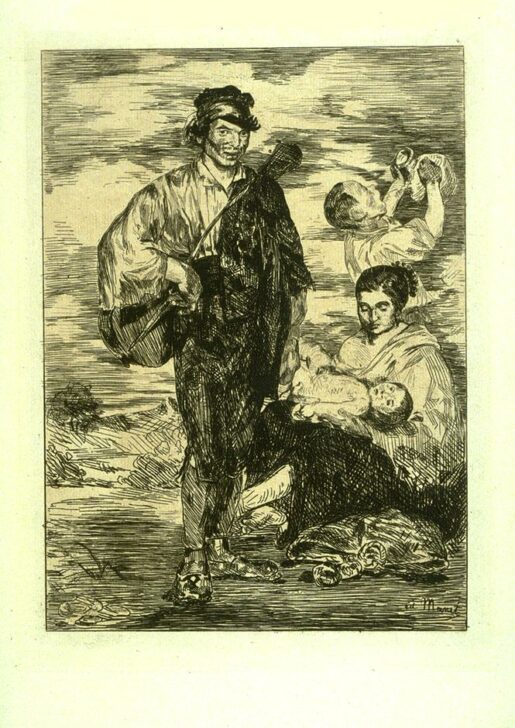Les Gitanos
Édouard Manet

Description
March 28, 2009
For many artists in mid-nineteenth-century France, the painting of Spain provided an alternative to the influence of Italian Renaissance art. Manet’s paintings and, later, his prints were deeply influenced by the examples of Goya, Murillo, and above all, Velázquez. The Gypsies combines aspects of two very different Spanish artists: the central commanding figure of the standing man is based on a royal portrait by Velázquez, while the mother and child are loosely based on paintings of peasants by Murillo. French artists freely combined Spanish “types” in their work and this pastiche (which also conjures up images of the Holy Family) must have been considered an awkward composition to Manet and may explain why he cut up his painting.
The Gypsies was the first etching that Manet published through the Société des Aquafortistes in 1862; he based this work on an earlier painting that he had cut down into small fragments.
Subject Matter:
Manet made this print after one of his own full-size oil paintings. The painting itself referenced several different sources. The Gypsies combines aspects of two very different Spanish artists: the central commanding figure of the standing man is based on a royal portrait by Velázquez, while the mother and child are loosely based on paintings of peasants by Murillo. French artists freely combined Spanish “types” in their work and this pastiche—which also conjures up images of the Holy Family—must have been considered an awkward composition to Manet and may explain why he cut up his painting.
Physical Description:
The main figure in this print is a man standing in contraposto pose in a generic outdoor setting. His right hand rests on his hip, a guitar is slung across his back, and a piece of cloth is tied around his head. His gaze meets that of the audience. He stands in the center of the composition. To his left is a seated woman with a naked baby in her lap; a sack lays on the ground next to her bare feet. Behind her, a standing boy leans his head backwards in order to drink from the upturned jug he holds. He is shown in profile. All of the depicted people wear simple, loose-fitting and slightly worn-looking costumes. Three-quarters of the background space is comprised of a cloudy sky; a rocky terrain is suggested in the midddle background.
The print is signed in the plate, lower right corner, "éd. Manet."
Usage Rights:
If you are interested in using an image for a publication, please visit https://umma.umich.edu/request-image/ for more information and to fill out the online Image Rights and Reproductions Request Form.